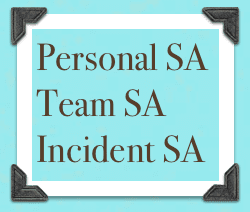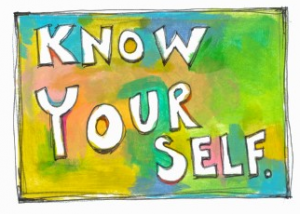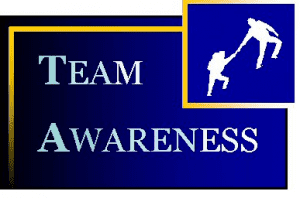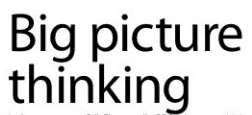 The mission of this website and my personal passion for situational awareness is to help first responders see the bad things coming in time to change the outcome. Consistent with that mission, I try to help responders understand how various aspects of the job – from training, to human factors, to command competence and everything in between – can influence situational awareness in high-stress, high-consequence decision making environments.
The mission of this website and my personal passion for situational awareness is to help first responders see the bad things coming in time to change the outcome. Consistent with that mission, I try to help responders understand how various aspects of the job – from training, to human factors, to command competence and everything in between – can influence situational awareness in high-stress, high-consequence decision making environments.
Now I want to introduce you to the concept that you have multiple situational awarenesses, three in fact. Each dimension of situational awareness requires you to capture clues and cues, comprehend those clues and cues into meaning and to predict future events. Let’s explore the three dimensions of your situational awareness.
Personal Situational Awareness
 This is your awareness of yourself, your abilities, inabilities, knowledge, skill set, fitness, stamina, fears and phobias. This SA is the comprehensive assessment of you, conducted by you. Technically, and I suppose literally, no one should know you any better. This should make you uniquely qualified to conduct an accurate assessment of what you are able to do. But there are a few things that can get in the way, namely, biases, assumptions and perceptions. As you assess yourself, you have certain perceptions about yourself and your abilities.
This is your awareness of yourself, your abilities, inabilities, knowledge, skill set, fitness, stamina, fears and phobias. This SA is the comprehensive assessment of you, conducted by you. Technically, and I suppose literally, no one should know you any better. This should make you uniquely qualified to conduct an accurate assessment of what you are able to do. But there are a few things that can get in the way, namely, biases, assumptions and perceptions. As you assess yourself, you have certain perceptions about yourself and your abilities.
I have seen many firefighters (myself being among them) who have inflated their perception of their physical abilities in spite of their age and declining physical conditioning. The mind can get stuck on the perception of the 21 year old, physically fit specimen that you once were. Unfortunately, time has a way of eroding the physical abilities but the mind can cling to the mental perception of stamina that has long since departed.
Some responders tend to be exceptionally generous in their self assessments, thinking they know more than they can actually recall, thinking they can perform better than they actually can perform, and believing there is no incident that can beat them. These individuals have a flawed personal situational awareness and this can be dangerous for themselves and others operating at the incident.
Personal situational awareness also includes an awareness of the individual’s role to be performed at an incident scene. It is one’s assessment of their familiarity with tools and equipment, ability to assess changing environmental factors, and the ability to remain calm and task-focused in a dynamic environment. In summary, it means knowing yourself realistically, demons and all.
Team Situational Awareness
 This dimension of situational awareness involves your assessment of your team, or company. The components of this assessment are the same only you’re evaluating fellow team members – their abilities, inabilities, knowledge, skill set, fitness, stamina, fears and phobias. You’ve heard it said that a team is only as strong as its weakest link. Team situational awareness ensures you understand, in advance, the strengths and weaknesses of team members before engaging in high-risk, high-consequence tasks.
This dimension of situational awareness involves your assessment of your team, or company. The components of this assessment are the same only you’re evaluating fellow team members – their abilities, inabilities, knowledge, skill set, fitness, stamina, fears and phobias. You’ve heard it said that a team is only as strong as its weakest link. Team situational awareness ensures you understand, in advance, the strengths and weaknesses of team members before engaging in high-risk, high-consequence tasks.
It stands to reason that the better you know team members the better you will be at developing situational awareness of the team. It’s hard to assess someone you don’t know very well. What do you base your assessment on? Assumptions perhaps. That can be OK so long as the assumptions are accurate. Making assumptions of team members abilities can result in bad outcomes. This goes for both assuming their abilities are better or worse than they actually are. The only way to really know your team is to get to know your team. This requires an investment of time and it starts with communication. With time the communication develops a relationship and the relationship builds trust. Once you trust someone, you can confidently put your life in their hands.
Team situational awareness also means understanding the role the team is supposed to play at the incident. It involves capturing clues and cues of the team’s role and environment, processing those clues and cues into meaning and making an accurate prediction of the outcome of the team’s performance. What will success look like when the team accomplishes the task? How long should it take for the team to accomplish the task? Does the team have any weak links that will require an adjustment?
Incident Situational Awareness
 The final dimension of situational awareness is for the overall incident. This ties all three together. You assess yourself and your knowledge, skills and abilities (fairly, both good and bad) and form personal situational awareness about the job you have to do. Then you assess your team’s knowledge skills and abilities (again, both good and bad) and form team situational awareness about the job the team has to do. Finally, you form an awareness of the overall incident. What is the strategy? What is the role of your team in accomplishing the overall strategy? What is the knowledge, skills and abilities of other teams and commanders?
The final dimension of situational awareness is for the overall incident. This ties all three together. You assess yourself and your knowledge, skills and abilities (fairly, both good and bad) and form personal situational awareness about the job you have to do. Then you assess your team’s knowledge skills and abilities (again, both good and bad) and form team situational awareness about the job the team has to do. Finally, you form an awareness of the overall incident. What is the strategy? What is the role of your team in accomplishing the overall strategy? What is the knowledge, skills and abilities of other teams and commanders?
It is very important to develop incident situational awareness because no individual or team operates in a vacuum. Everyone’s role is part of a bigger strategy and awareness of everyone’s role helps improve personal and team safety. On occasion I have seen, heard and read about incidents where individuals and teams operate independently. Almost as though they have blinders on, they perform their tasks with little concern or awareness of the overall incident’s coordination.
While it is command’s role to coordinate the overall incident, it is every responder’s role to develop and maintain personal, team and incident situational awareness.
Dr. Gasaway’s Advice
 Personal and team situational awareness can begin well in advance of an emergency. This may involve conducting an inventory of assets and liabilities. When assessing yourself, be realistic. You have no one to fool but yourself and the consequences to you can be significant if you’re not realistic. If you identify shortcomings, develop a plan for self improvement. As difficult as it may be, it may be very beneficial to discuss your shortcomings and personal concerns with fellow team members. If they are aware of them, they may be able to help you overcome them or, alternatively, compensate for them. For example, if you don’t like heights it might be good for your team to know that before you end up petrified on a rooftop.
Personal and team situational awareness can begin well in advance of an emergency. This may involve conducting an inventory of assets and liabilities. When assessing yourself, be realistic. You have no one to fool but yourself and the consequences to you can be significant if you’re not realistic. If you identify shortcomings, develop a plan for self improvement. As difficult as it may be, it may be very beneficial to discuss your shortcomings and personal concerns with fellow team members. If they are aware of them, they may be able to help you overcome them or, alternatively, compensate for them. For example, if you don’t like heights it might be good for your team to know that before you end up petrified on a rooftop.
Team assessments can be conducted through practical evolutions and through discussing the results of personal assessments. Perhaps have each team member complete a personal assets and liabilities survey and then share those with each other. Yes, this can be risky and it may lead to guarded responses for fear of ridicule and embarrassment. You can either reveal it in advance to your fellow team members and work with them on a resolution or let it rise to the surface during an emergency incident and put the entire team in jeopardy. The potential consequence is too great to allow assumptions to determine fellow team members abilities.
To develop incident awareness requires understanding about what is happening on the large scale. This is accomplished by being aware that everyone on the incident scenes are, proverbially, actors in a big movie. Everyone has a role and no one’s role is independent of anyone else’s. It all goes together.
Discussions
1. Discuss strategies to develop and maintain personal, team and incident situational awareness.
2. Discuss signs and symptoms indicating a potential loss of individual, team or incident situational awareness.
3. Discuss the consequences of lost personal, team and/or incident situational awareness.
_____________________________________________________

If you are interested in taking your understanding of situational awareness and high-risk decision making to a higher level, check out the Situational Awareness Matters Online Academy.
CLICK HERE for details, enrollment options and pricing.
__________________________________
Share your comments on this article in the “Leave a Reply” box below. If you want to send me incident pictures, videos or have an idea you’d like me to research and write about, contact me. I really enjoy getting feedback and supportive messages from fellow first responders. It gives me the energy to work harder for you.
Thanks,

Email: Support@RichGasaway.com
Phone: 612-548-4424
SAMatters Online Academy
Facebook Fan Page: www.facebook.com/SAMatters
Twitter: @SAMatters
LinkedIn: Rich Gasaway
YouTube: SAMattersTV
iTunes: SAMatters Radio
